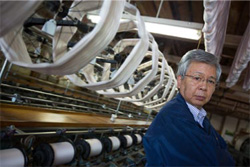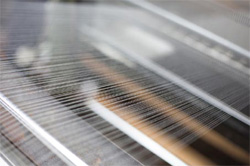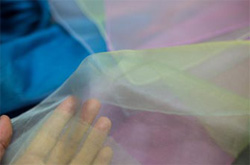Home > Highlighting JAPAN > Highlighting Japan JULY 2012 > Silk Roads
Highlighting JAPAN
[SERIES] JAPAN BRAND
Silk Roads
Saiei Orimono in Kawamata is the purveyor of the world's finest silk. Gavin Blair visited the Fukushima Prefecture-company, which continues its pursuit of highest-quality merchandise in the most difficult of times.

Yasuyuki Saito, president of Saiei Orimono, in the silk factory founded by his father
Credit: JEREMY SUTTON-HIBBERT

Bundles of fine-spun silk ready for weaving
Credit: JEREMY SUTTON-HIBBERT
The company currently has seventeen employees, with five "masters" of the five crucial skills required for silk production. New staff must spend a year learning each of at least three of them.

Strands of the world's finest, Fairy Feather silk on the loom at Saiei Orimono
Credit: JEREMY SUTTON-HIBBERT
Like most companies in the apparel or fabrics business, Saiei Orimono has been vulnerable to the vagaries of trends and fashions.
"When the current Crown Prince married Princess Masako [1993], there was a 'scarf boom' in Japan because the princess liked to wear silk scarves, but since then they haven't really been popular," explains Saito.

A wedding dress by the world famous designer of haute couture bridal gowns Yumi Katsura, using Saiei Orimono's ultra-thin silk
Credit: COURTESY OF SAIEI ORIMONO

Colored silk scarves made from Saiei Orimono's award-winning Fairy Feather silk
Credit: JEREMY SUTTON-HIBBERT
"The office and factory were a mess, with stuff all over place, things broken and the equipment out of alignment. But all the staff came to help clear up."
On this note, Saito reflects, the biggest influence of the disasters has been that people have come to realize the importance of human relations, of friends and family, and the ties that bind them together.
Looking forward, the company is working on opening sales channels for its award-winning Fairy Feather silk in Europe, with one French company having already taken samples and now considering whether to begin using the unique fabric.
© 2009 Cabinet Office, Government of Japan






